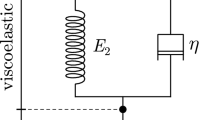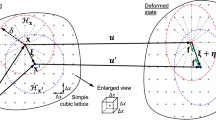Abstract
For a wide variety of quasi-brittle materials, the constitutive microplane models of damage are capable of describing the anisotropic development and growth of microcracks when materials exhibit inelastic response. Damage development in solids leads to the degradation of the macroscopic material stiffness and results in different response in loading and unloading. On the other hand, the constitutive microplane models of plasticity describe the anisotropic plastic sliding that originates macroscopic permanent deformation and remains upon unloading. For realistic modeling of these materials, in which both damage and plasticity mechanisms can evolve simultaneously, the microplane damage and plasticity models can be coupled in a systematic and robust manner. This work presents a theoretical formulation of a consistent framework to couple both microplane damage and plasticity models for triggering inelastic behavior (damage and plastic effects) in engineering materials. Throughout the derivation, it is specifically shown that the proposed derivation complies with the thermodynamical restrictions with regard to the assessment of the local energy dissipation based on the Clausius–Duhem inequality. Finally, the algorithmic treatment of the developed constitutive framework is outlined for its incorporation into incremental-iterative solution procedures using Newton–Raphson schemes and examined by means of simple benchmark examples.





Similar content being viewed by others
References
Abu Al-Rub RK, Voyiadjis GZ (2003) On the coupling of anisotropic damage and plasticity models for ductile materials. Int J Solids Struct 40:2611–2643
Bazant ZP, Oh B (1983) Microplane model for fracture analysis on concrete structures. In: Proceedings on the symposium on the interaction of non-nuclear munitions with structures, US Air Force Academy, Colorado Springs, pp 49–55
Bazant ZP, Caner FC, Carol I, Adley MD, Akers SA (2000) Microplane model m4 for concrete. I: formulation with work-conjugate deviatoric stress. J Eng Mech 126:944–953
Bazant ZP, Gambrova PG (1984) Crack shear in concrete: crack band microplane model. J Struct Eng ASCE 110:2015–2036
Bazant ZP, Di Luzio G (2004) Nonlocal microplane model with strain-softening yield limits. Int J Solids Struct 41:7209–7240
Bazant ZP, Oh BH (1983) Crack band theory for fracture of concrete. Mater Struct 16:155–177
Bazant ZP, Oh B (1985) Microplane model for progressive fracture of concrete and rock. J Eng Mech 111:559–582
Bazant ZP, Ozbolt J (1990) Nonlocal microplane model for fracture, damage, and size effect in structures. J Eng Mech 116:2485–2505
Belytschko T, Xiao SP (2003) Coupling methods for continuum model with molecular model. Int J Multiscale Comput Eng 1(1):115–126
Belytschko T, Xiao SP (2004) A bridging domain method for coupling continua with molecular dynamics. Comput Methods Appl Mech Eng 193(17–20):1645–1669
Benallal A, Billardon R, de Doghri L (1988) An integration algorithm and the corresponding tangent operator for fully coupled elastoplastic and damage equations. Commun Numer Methods Eng 4(731–740):1988
Budarapu P, Gracie R, Stephane B, Rabczuk T (2014) An adaptive multiscale method for quasi-static crack growth. Comput Mech 53(6):1129–1148
Budarapu PR, Gracie R, Shih-Wei Y, Zhuang X, Rabczuk T (2014) Efficient coarse graining in multiscale modeling of fracture. Theor Appl Fract Mech 69:126–143
Budarapu PR, Javvaji B, Sutrakar VK, Roy Mahapatra D, Zi G, Rabczuk T (2015) Crack propagation in graphene. J Appl Phys 118:064307
Caner F, Carol I (2006) Microplane constitutive model and computational framework for blood vessel tissue. J Biomech Eng 128:419–427
Carol I, Prat PC, Bazant ZP (1992) New explicit microplane model for concrete: theoretical aspects and numerical implementation. Int J Solids Struct 29:1173–1191
Carol I, Jirasek M, Bazant ZP (2001) A thermodynamically consistent approach to microplane theory. Part I. Free energy and consistent microplane stresses. Int J Solids Struct 38:2921–2931
Carol I, Jirasek M, Bazant BZ (2004) A framework for microplane models at large strains, with application to hyperelasticity. Int J Solids Struct 41:511–557
Cicekli U, Voyiadjis GZ, Abu Al-Rub RK (2007) A plastic and anisotropic damage model for plain concrete. Int J Plast 23:1874–1900
Coleman BD, Noll W (1963) The thermodynamics of elastic materials with heat conduction and viscosity. Arch Ration Mech Anal 13:167–178
de Borst R, Pamin J, Peerlings RHJ, Sluys LJ (1995) On gradient-enhanced damage and plasticity models for failure in quasibrittle and frictional materials. J Comput Mech 17:130–141
Fleischhauer R, Behnke R, Kaliske M (2013) A thermomechanical interface element formulation for finite deformations. Comput Mech 52:1039–1058
Fuina JS, Pitangueira RLS, Penna SS (2011) A comparison of two microplane constitutive models for quasi-brittle materials. Appl Math Model 35:5326–5337
Gracie R, Belytschko T (2008) Concurrently coupled atomistic and XFEM models for dislocations and cracks. Int J Numer Methods Eng 78(3):354–378
Guidault P-A, Belytschko T (2009) Bridging domain methods for coupled atomistic continuum models with L2 or H1 couplings. Int J Numer Methods Eng 77(11):1566–1592
Holzapfel GA (2000) Nonlinear Solid Mechanics: A Continuum Approach for Engineering. Wiley, Chichester
Ibrahimbegovic A, Markovic D, Gatuingt F (2003) Constitutive model of coupled damage-plasticity and its finite element implementation. Eur J Comput Mech 12:381–405
Jirasek M (1998) Nonlocal models for damage and fracture: comparison of approaches. Int J Solids Struct 35(31):4133–4145
Jirasek M, Bazant ZP (1994) Localization and nonlocal model based on crack interactions. J Eng Mech ASCE 120(7):1521–1542
Jirasek M, Bazant ZP (2002) Inelastic analysis of structures. Wiley, London ISBN: 0-471-98716-6
Kachanov L (1986) Introduction to continuum damage mechanics. Martinus Nijhoff Publishers, Dordrecht ISBN 978-94-017-1957-5
Kratzig W, Polling R (2004) An elasto-plastic damage model for reinforced concrete with minimum number of material parameters. Comput Struct 82:1201–1215
Kuhl E, Carol I, Steinmann P (2001) New thermodynamic approach to microplane model. Part II: dissipation and inelastic constitutive modelling. Int J Solids Struct 38:2933–2952
Kuhl E, Ramm E (2000) Microplane modelling of cohesive frictional materials. Eur J Mech A Solids 19:121–143
Lemaitre J (1985) Coupled elasto-plasticity and damage constitutive equations. Comput Methods Appl Mech Eng 51:31–49
Lemaitre J, Chaboche JL (1990) Mechanics of solid materials. Cambridge University Press, Cambridge
Leukart M, Ramm E (2003) A comparison of damage models formulated on different material scales. Comput Mater Sci 28:749–762
Leukart M, Ramm E (2006) Identification and interpretation of microplane laws. J Eng Mech 132:295–305
Linder C, Armero F (2007) Finite elements with embedded strong discontinuities for the modeling of failure in solids. Int J Numer Methods Eng 72:1391–1433
Lubarda VA, Krajcinovic D (1993) Damage tensors and the crack density distribution. Int J Solids Struct 30:2859–2877
Mazars J, Pijaudier-Cabot G (1989) Continuum damage theory application to concrete. J Eng Mech 115:345–365
Menzel A, Ekh M, Steinmann P, Runesson K (2002) Anisotropic damage coupled to plasticity: modelling based on the effective configuration concept. Int J Numer Methods Eng 54(10):1409–1430
Menzel A, Steinmann P (2001) A theoretical and computational framework for anisotropic continuum damage mechanics at large strains. Int J Solids Struct 38:9505–9523
Meschke G, Lackner R, Mang HA (1998) An anisotropic elastoplastic-damage model for plain concrete. Int J Numer Methods Eng 42:703–727
Oliver J (1989) A consistent characteristic length for smeared cracking models. Int J Numer Methods Eng 28:461–474
Oliver J (1996) Modelling strong discontinuities in solid mechanics via strain softening constitutive equations. Part 1: fundamentals, part 2: numerical simulation. Int J Numer Methods Eng 39:3575–3623
Ortiz M (1985) A constitutive theory for the inelastic behavior of concrete. Mech Mater 4:67–93
Ortiz M, Pandolfi A (1999) Finite-deformation irreversible cohesive elements for three-dimensional crack-propagation analysis. Int J Numer Methods Eng 44:1267–1282
Paggi M, Reinoso J (2015) An anisotropic large displacement cohesive zone model for fibrillar and crazing of interfaces. Int J Solids Struct 69–70:106–120
Paggi M, Wriggers P (2012) Stiffness and strength of hierarchical polycrystalline materials with imperfect interfaces. J Mech Phys Solids 60:557–572
Peric D, De Saouza Neto EA, Owen DRJ (2007) Computational methods for plasticity: theory and applications. Wiley, London ISBN 9780470694527
Reinoso J, Paggi M (2014) A consistent interface element formulation for geometrical and material nonlinearities. Comput Mech 54(6):1569–1581
Sidoroff F (1981) Description of anisotiopic damage application to elasticity. In: IUTAM Colloquium on physical nonlinearities in structural analysis, pp 237–244
Simo JC (1987) On a fully three-dimensional finite-strain viscoelastic damage model: formulation and computational aspects. Comput Methods Appl Mech Eng 60:153–173
Simo JC, Ju W (1987) Stress and strain-based continuum damage model I. Formulation, II. Computational aspects. Int J Solids Struct 23:821–869
Talebi H, Silani M, Bordas SPA, Kerfriden P, Rabczuk T (2013) Molecular dynamics/XFEM coupling by a three-dimensional extended bridging domain with applications to dynamic brittle fracture. Int J Multiscale Comput Eng 11(6):527–541
Taylor RL (2014) Feap user manual. http://www.ce.berkeley.edu/projects/feap/manual.pdf
Voyiadjis GZ, Taqieddin ZN, Kattan PI (2008) Anisotropic damage-plasticity model for concrete. Int J Plast 24:1946–1965
Voyiadjis GZ, Abu Al-Rub RK (2006) A finite strain plastic-damage model for high velocity impact using combined viscosity and gradient localization limiters: part II numerical aspects and simulations. Int J Damage Mech 15:335–373
Waffenschmidt T, Polindara C, Menzel A, Blanco S (2014) A gradientenhanced large-deformation continuum damage model for fibre-reinforced materials. Comput Methods Appl Mech Eng 268:801–842
Yang SW, Budarapu PR, Mahapatra DR, Bordas SPA, Zi G, Rabczuk T (2015) A meshless adaptive multiscale method for fracture. Comput Mater Sci 96:382–395
Zreid IM, Kaliske M (2014) Regularization of microplane damage models using an implicit gradient enhancement. Int J Solids Struct 51:3480–3489
Acknowledgments
RR and AD would like to acknowledge the German Research Foundation (DFG) for the financial support through the priority Program 1640 forming by plastic deformation’ with contract No. RO 706/6-1. JR is grateful to the financial support of the Andalusian Government (Project of Excellence No. TEP-7093) and the Spanish Ministry of Economy and Competitiveness/FEDER (DPI2012-37187).
Author information
Authors and Affiliations
Corresponding author
Rights and permissions
About this article
Cite this article
Dean, A., Sahraee, S., Özenc, K. et al. A thermodynamically consistent framework to couple damage and plasticity microplane-based formulations for fracture modeling: development and algorithmic treatment. Int J Fract 203, 115–134 (2017). https://doi.org/10.1007/s10704-016-0131-9
Received:
Accepted:
Published:
Issue Date:
DOI: https://doi.org/10.1007/s10704-016-0131-9




